Content for TS 26.501 Word version: 18.3.1
4 Media Streaming architecture
4.0 Media Streaming features (informative)
4.0.1 Introduction
4.0.2 Content hosting
4.0.3 Content publishing
4.0.4 Content preparation
4.0.5 Network assistance
4.0.6 Dynamic policies
4.0.7 Remote control
4.0.8 Consumption reporting
4.0.9 QoE metrics reporting
4.0.10 Edge processing
4.0.11 eMBMS delivery
4.0.12 Data collection, reporting and exposure
4.0.13 Service URL handling
...
...
4 Media Streaming architecture p. 15
4.0 Media Streaming features (informative) p. 15
4.0.1 Introduction p. 15
This clause defines a set of high-level features for supporting enhanced media streaming in the 5G System. The functional architecture of this 5G Media Streaming (5GMS) System is defined in clause 4.1 and is further specialised for downlink media streaming (clause 4.2) and uplink media streaming (clause 4.3). Procedures for downlink media streaming are defined in clause 5 and those for uplink media streaming in clause 6.
In the context of the present document, streaming is defined as the delivery of time-continuous media as the predominant media. Streaming points to the fact that the media is predominantly sent only in a single direction and consumed as it is received. Additionally, the media content may be streamed as it is produced, referred to as live streaming. If content is streamed that is already produced, it is referred to as on-demand streaming.
References to Dynamic Adaptive Streaming over HTTP (MPEG-DASH) [29] in the present document apply equally to HTTP Live Streaming (HLS) [28] except where noted otherwise. The term Media Entry Point is used to refer generically to an MPEG-DASH Media Presentation Description (MPD) but may be taken to apply equally to alternative media presentation description formats such as an HLS master playlist, unless noted otherwise.
Table 4.0.1-1 lists the principal features of the 5GMS architecture along with cross-references to relevant clauses defining its functions and procedures.
| Feature | Feature description clause | Procedure definition clause(s) | |
|---|---|---|---|
| Downlink media streaming | Uplink media streaming | ||
| Content hosting | 4.0.2 | 5.4 | Not applicable |
| Content publishing | 4.0.3 | Not applicable | 6.2.3 |
| Content preparation | 4.0.4 | Not defined | Not defined |
| Network assistance | 4.0.5 | 5.9 | 6.5, 6.7 |
| Dynamic policies | 4.0.6 | 5.8, 5.7.6 | 6.9 |
| Remote control | 4.0.7 | Not applicable | 6.6 |
| Consumption reporting | 4.0.8 | 5.6 | Not applicable |
| QoE metrics reporting | 4.0.9 | 5.5 | Not applicable |
| Edge processing | 4.0.10 | 8 | |
| eMBMS delivery | 4.0.11 | 5.10 | Not applicable |
| Data collection, reporting and exposure | 4.0.12 | 5.11 | 6.8 |
| Service URL handling | 4.0.13 | 9, 5.10.7 | 9 |
The following clauses introduce these features in terms of network-side components ("5GMS network services") and a UE-side client component referred to variously as the 5GMSd Client (for downlink media streaming), 5GMSu Client (for uplink media streaming), or simply 5GMS Client (in the case of features applicable to either downlink media streaming or uplink media streaming).
4.0.2 Content hosting p. 16
The content hosting feature is applicable to downlink media streaming only. It provides a service equivalent to a Content Delivery Network (CDN) deployed inside or outside the Trusted DN. High-level procedures for this feature are defined in clause 5.4.
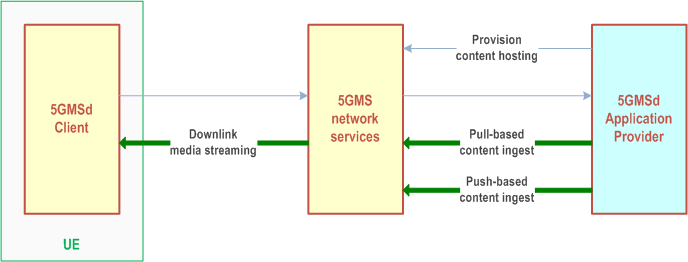
When a 5GMSd Application Provider has provisioned the content hosting feature for downlink media streaming:
- Media content is either retrieved by a network-side component of the 5GMS System from a media origin at the 5GMSd Application Provider (pull-based content ingest) or else it is published to a network-side component of the the 5GMS System by the 5GMSd Application Provider (push-based content ingest).
- The network-side component of the 5GMS System may cache this content for a configurable period of time.
- Network-side components of the 5GMS System may manipulate the content according to rules provisioned in Content Preparation Templates (see clause 4.0.4).
- The 5GMSd Client in the UE subsequently retrieves the (possibly manipulated) media content as part of a downlink media streaming session. The security of the content served to the 5GMSd Client by network-side components of the 5GMS System may be guaranteed by a provisioned Server Certificate.
4.0.3 Content publishing p. 17
The content publication feature is applicable to uplink media streaming only. High-level procedures for this feature are defined in clause 6.2.3.
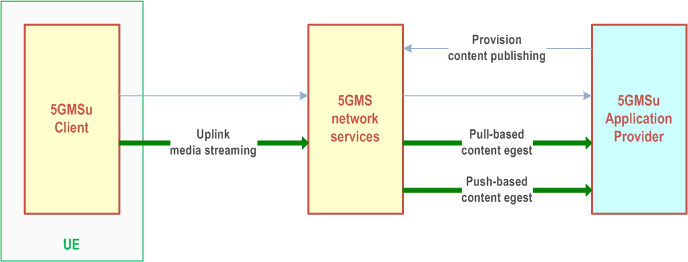
When a 5GMSu Application Provider has provisioned the content publishing feature for uplink media streaming:
- Media content is published by the 5GMSu Client in the UE to a network-side component of the 5GMS System as part of an uplink media streaming session. The security of the content published to the 5GMS System may be guaranteed by a provisioned Server Certificate.
- The network-side component of the 5GMS System may cache this content for a configurable period of time.
- Network-side components of the 5GMS System may manipulate the content according to rules provisioned in Content Preparation Templaes (see clause 4.0.4).
- A network-side component of the 5GMS System makes the media content available for retrieval by the 5GMSu Application Provider (pull-based content egest) or publishes it directly to the 5GMSu Application Provider (push-based content egest).
4.0.4 Content preparation p. 17
The content preparation feature is applicable to both downlink media streaming (where is is provisioned as part of the content hosting feature introduced in clause 4.0.2) and uplink media streaming (where is is provisioned as part of the content publishing feature introduced in clause 4.0.3). The content preparation feature enables a 5GMS Application Provider to specify content manipulation by network-side components of the 5GMS System according to provisioned Content Preparation Templates.
When a 5GMSd Application Provider has provisioned the content preparation feature for downlink media streaming:
- Network-side components of the 5GMS System may manipulate ingested media content and may cache the manipulated content prior to serving it to the 5GMSd Client in the UE.
- Network-side components of the 5GMS System may manipulate the media content ingested from the 5GMSu Client in the UE and may cache the manipulated content prior to egesting it to the 5GMSu Application Provider.
4.0.5 Network assistance p. 18
The network assistance feature is applicable to both downlink media streaming and uplink media streaming. It enables the 5GMS Client in the UE to interrogate or manipulate the network Quality of Service for an ongoing media streaming session.
High-level procedures for this feature are defined in clause 5.9 (downlink media streaming) and in clauses 6.1, 6.5 and 6.7 (uplink media streaming). The network assistance feature is not explicitly provisioned by the 5GMS Application Provider. It is either available for a particular media streaming session or not, depending on system pre-configuration and/or policy.
Two mechanisms for obtaining network assistance are defined in the present document: one based on interactions with the PCF via network-based components of the 5GMS System (AF-based network assistance), the other based on ANBR signalling interactions between the UE modem and the RAN (ANBR-based network assistance).
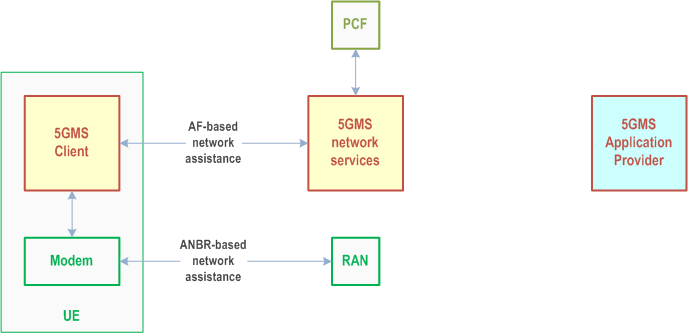
The following AF-based network assistance sub-features are defined in this release:
- Bit rate recommendation (or throughput estimation): The 5GMS Client requests an estimate from a network-side component of the 5GMS System of the bit rate that can currently be offered by a media streaming session. The network-side component interrogates the PCF on behalf of the 5GMS Client to obtain this information about the PDU session corresponding to the media streaming session. The 5GMS Client uses this information to adjust its own streaming bit rate to fit within the Quality of Service (QoS) envelope that the network is able to offer, for example by switching to a different representation listed in its Media Entry Point, or by adjusting the encoding bit rate for uplink streaming to fits within this bit rate budget. The media streaming Quality of Experience (QoE) is more stable and consistent as a consequence.
- Delivery boost: The 5GMS Client speculatively requests a temporary boost to the bit rate of a media streaming session from a network-side component of the 5GMS System. The network-side component requests a modification to the PDU session corresponding to the media streaming session from the PCF on behalf of the 5GMS Client. If there is sufficient spare network capacity to accommodate the requested bit rate, it is granted by the 5GMS System on a temporary basis. The 5GMS Client uses this temporary boost to speed up media streaming data transfer, for example to replenish a depleted downlink streaming buffer or to complete a download/upload faster than would otherwise be possible.
4.0.6 Dynamic policies p. 19
The dynamic policies feature is applicable to both downlink media streaming and uplink media streaming. It enables the 5GMS Client in the UE to manipulate the network traffic handling policies for an ongoing media streaming session.
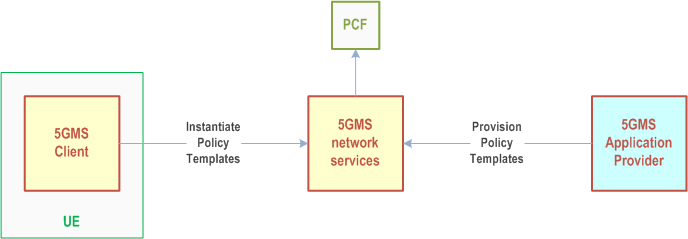
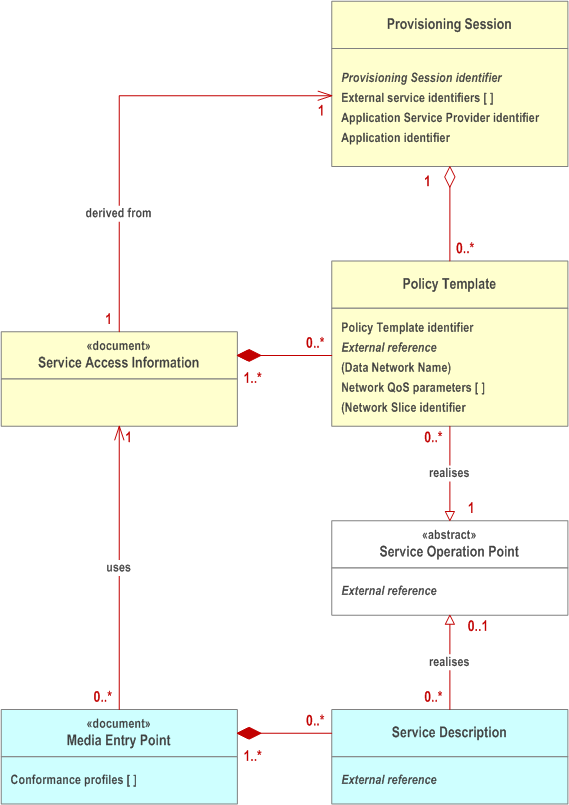
With reference to Figure 4.0.6-2, dynamic policies work as follows:
- A conceptual Service Operation Point is an abstract set of requirements that support a media streaming service (e.g., SD, HD, UHD). It is identified by an External reference that is used to tag Policy Template resources provisioned in the 5GMS System and Service Descriptions included in Media Entry Point documents.
- The Service Operation Point is embodied in the 5G System by a Policy Template which is provisioned in the 5GMS network services by the 5GMS Application Provider within the scope of an umbrella Provisioning Session. A Policy Template may be defined as being applicable to a particular Data Network and/or Network Slice. The Policy Template carries the External reference and Network QoS parameters corresponding to a single Service Operation Point. (Any number of Policy Templates provisioned for different Data Networks and/or Network Slices may reference the same Service Operation Point.)
- The 5GMS Application Provider makes one or more Media Entry Point documents (e.g. DASH MPDs) available for use by the 5GMS Client. To take advantage of the dynamic policies feature, a Media Entry Point document includes one or more Service Descriptions, each identifying the streaming requirements of a presentation that correspond to a single Service Operation Point (e.g., SD, HD, UHD) and identified by means of an External reference. The same Service Description may be included in more than one Media Entry Point document in case a common Service Operation Point is applicable to multiple media presentations.
- When a Media Entry Point is selected by the 5GMS Client at the start of a media streaming session, the 5GMS Client retrieves Service Access Information from a network-side component of the 5GMS System describing the set of available Policy Templates provisioned in step 2 and exposes this to a controlling application on the UE.
- At the start of a media streaming session, the controlling application on the UE selects one of the Service Descriptions listed in the Media Entry Point document that realises its preferred Service Operation Point. Either the Media Player (when the Service Descriptions are within the Media Entry Point document) or the controlling application (when the Service Descriptions are not within the Media Entry Point document) informs the 5GMS Client of its choice by passing the corresponding External reference to it.
- If there is a Policy Template available for the current media streaming session with the indicated External reference, the 5GMS Client instantiates this Policy Template by interacting with a network-side component of the 5GMS System in order to realise the Service Operation Point described by the Policy Template and the Service Description. The effect of this is that the corresponding network Quality of Service is applied to the media streaming session.
4.0.7 Remote control p. 20
The remote control feature is applicable to uplink media streaming only. While high-level procedures for integrating this feature into 5G Media Streaming are specified in clause 6.6 of the present document, it is not further defined in this release.
4.0.8 Consumption reporting p. 20
The consumption reporting feature is applicable to downlink media streaming only in this release. It allows consumption of downlink media streaming to be logged by the 5GMS System and exposed for analysis.

When a 5GMSd Application Provider has provisioned the consumption reporting feature for downlink media streaming:
- The 5GMSd Client reports consumption of media that is part of downlink media streaming sessions to a network-side component of the 5GMS System.
4.0.9 QoE metrics reporting p. 21
The QoE metrics reporting feature is applicable to downlink media streaming only in this release. It allows the Quality of Experience of media streaming sessions to be logged by the 5GMS System and exposed for analysis.
Two mechanisms for reporting downlink QoE metrics are defined in the present document: one that involves reports being sent to the OAM via the RAN (RAN-based QoE metrics reporting, see clause 5.5.2), the other involving reports sent to the network-based components of the 5GMS System (AF-based QoE metrics reporting, see clause 5.5.3).
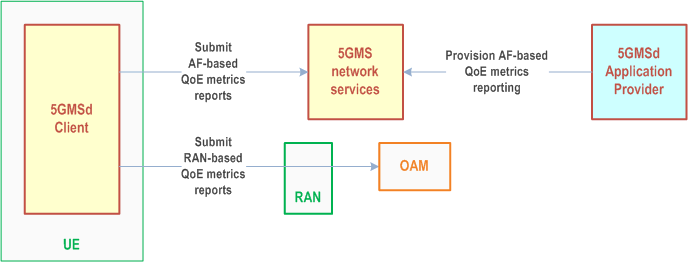
When a 5GMS Application Provider has provisioned the QoE metrics reporting feature for media streaming:
- The 5GMS Client reports QoE metrics that it has collected during media streaming sessions to a network-side component of the 5GMS System.
4.0.10 Edge processing |R17| p. 21
The edge processing feature is applicable to both downlink media streaming and uplink media streaming. It enables the 5GMS Client in the UE to take advantage of edge computing capabilities in the 5GMS System to support media streaming. This feature is defined in clause 4.5 and high-level procedures are defined in clause 8.
4.0.11 eMBMS delivery |R17| p. 21
The eMBMS delivery feature is applicable to downlink media streaming only. It enables the 5GMS System to provision the delivery of downlink media streaming content via eMBMS User Services sessions. This feature is defined in clause 4.6 and high-level procedures are defined in clause 5.10.
4.0.12 Data collection, reporting and exposure |R17| p. 21
The data collection, reporting and exposure feature is applicable to both downlink media streaming and uplink media streaming. It enables the 5GMS System to log data relating to media streaming sessions and to expose this to subscribers in the form of Events. This feature is defined in clause 4.7 and high-level procedures are defined in clause 5.11 (for downlink media streaming) and clause 6.8 (for uplink media streaming).
4.0.13 Service URL handling |R18| p. 22
Service URL handling is applicable to downlink and uplink media streaming. This feature is defined in clause 4.10 and high-level procedures are defined in clause 9.
The intent of 3GPP Service URL handling is to launch UE functions based on the execution of a URL. This enables 5G Media Streaming services to be announced within a third-party application, a general web page, a messaging service or shared via social messages using a 3GPP Service URL for 5GMS. When a service is launched using a 3GPP Service URL for 5GMS, a 5GMS Client function for media session handling is expected to be launched implicitly alongside, for example, a primary media stream handling function.